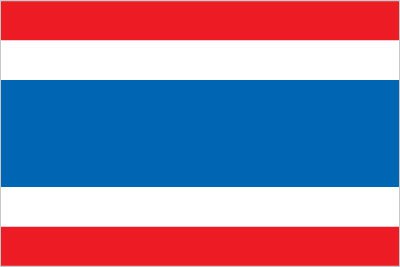FACT FILE
CAPITAL Bangkok
POPULATION 68.49 million
LANGUAGE Thai
TIME ZONE GMT+7, +6 in summer
CURRENCY Baht (฿)
ELECTRICITY 220v 50Hz
FLAG
Red symbolizes the blood of life; white stands for the purity of the Buddhist faith; blue represents the Thai monarchy
FLIGHTS TO THAILAND
From the UK, British Airways, Thai Airways and Eva Air (normally the cheapest) fly direct daily from Heathrow to Bangkok (which is where our Big Trip Thailand itinerary starts). Otherwise, you can generally get cheaper (but longer) flights with Norwegian, who fly via Oslo.
From Ireland, you’ll need to fly to Thailand via the UK or Europe. Norwegian (via Oslo) and Eva Air (via London) offer the best fares from Dublin, but there are plenty of other options, including Finnair (via Helsinki) and Etihad (via Abu Dhabi).
From the US, the closest thing to a direct flight to Thailand is Emirate’s services from New York to Bangkok, which has an hour stopover in Dubai. You can fly via Europe, Asia and other parts of the Middle East from most major American cities – the best-value flights from New York tend to be with Norwegian (via Oslo) or Qatar Airways (via Doha), and from Los Angeles with Eva Air (via Taipei in Taiwan).
From Canada, the quickest one-stop flights to Thailand from Toronto and Vancouver are with Air Canada (via Hong Kong or Seoul), the cheapest are generally with Eva Air (via Tapei).
You can search for the most convenient routes and the best fares at Skyscanner. Most international flights from Europe and North America arrive at Suvarnabhumi Airport (BKK), 25km east of Bangkok; taxis run into the city centre, or you can hop on the Bangkok Airport Rail Link to Makkasan (for the MRT into town) or Phaya Thai (for the BTS Skytrain). Flight times to Bangkok are around 11 hours 30 minutes from London and around 20 hours from New York and Toronto, 19 hours 30 minutes from Los Angeles and 17 hours 30 minutes from Vancouver.
VISAS AND PASSPORTS
For stays of up to 30 days, UK, Irish, US and Canada passport holders do not require a visa to visit Thailand. If you’re a citizen of one of these countries, your passport needs to be valid for at least six months from the date of arrival. Entry requirements do change, however, so check the latest with Thailand’s Ministry of Foreign Affairs.
HEALTH AND SAFETY IN THAILAND
Thailand is one of the safest countries to visit in Southeast Asia. In addition to the inoculations that are part of the routine childhood immunisation programme in the UK (ie diphtheria, tetanus, polio), the only other vaccination you are normally advised to have is typhoid, though some practitioners will also recommend rabies for children as well. Remember to check with your GP at least six weeks before you travel, and make sure you take out sufficient travel insurance for your trip.
The most common problem for kids is an upset tummy, the risk of which can be reduced by practising good hygiene (applying hand gel fairly regularly also helps) and taking sensible precautions with food and water – avoid unwashed fruit and salads, only buy street food that you can see being cooked in front of you and only drink bottled water. If you have food allergies, it’s a good idea to carry a dietary card, which explains (in Thai) the food(s) you’re allergic to and also reminds the chef that foods can be contaminated during preparation as well. This is particularly useful if you have a peanut allergy, as these appear in many dishes in Thailand (eg satay, pad thai, massaman curry, Khao Soi curry, Panang curry) and the possible severity of an anaphylactic reaction is not always understood.
Protect yourselves from the sun and make sure that everyone drinks plenty of water.
The flu-like dengue fever is present in Thailand, though most cases occur in urban areas and during the rainy season. Thailand also has a malaria risk, but this is confined to a strip along the border with Myanmar (Burma), parts of the borders with Laos, Cambodia and Malaysia and in an isolated spot in Surat Thani province (none of which feature in our Big Trip). The country is currently considered to have a moderate risk of Zika virus transmission, so if you’re pregnant (or are planning a family), you should consider postponing your trip. For all of these, avoiding being bitten is the best prevention. The mosquitos that transmit dengue and Zika bite between dawn and dusk, so where possible cover up with long-sleeved shirts and trousers, apply insect repellent on exposed skin (DEET is the most effective but it reduces the SPF in sun cream, and you should only give children products that contain less than 30 percent DEET; we use Citronella) and sleep under a net – most places to stay will have screens on their windows and mosquito nets set up around the beds.
Rabies is prevalent throughout Thailand and can be carried by dogs, monkeys and bats; it’s transmitted by a bite or scratch or (rarer) the licking of an open wound. Vaccinations are generally only advised for people staying in remote areas, and for a long time; it is usually enough to warn children not to approach stray dogs, particularly in Bangkok, and to avoid monkeys, though their natural inclination to pet any animal they see can make them vulnerable. If bitten or scratched, wash with soup and water, clean the wound with iodine or alcohol and seek medical attention immediately.
It is (quite literally) often a jungle out there, so you’re probably going to encounter quite a few big bugs and possibly some snakes. Most of them are completely harmless and fascinating for kids, but – although you’re highly unlikely to encounter any of Thailand’s venomous species – it’s still useful to know to avoid the Malayan pit viper (with its triangular head and dark-brown triangular blotches along its body), cobra (easily recognised by its hood) and the nocturnal banded krait (yellow-and-black stripes). Storms, particularly in the monsoon season, can wash jellyfish close to the shores of Southern Thailand’s beaches. Again, most are harmless or leave an irritable sting at worst – rash vests, which also protect against the sun, can help prevent stings, but if you are stung, apply vinegar to the area and cover it with sand. In the rainy season, venomous box jellyfish are sometimes found in the Andaman Sea and in the Gulf of Thailand but in areas (ie Ko Lanta, Hua Hin and Ko Samui) that do not feature in our Big Trip itinerary.
GETTING AROUND THAILAND
Travelling around Thailand is all part of the fun, and no trip would be complete without a train ride through the countryside or a tuk-tuk spin round Bangkok. Buses are the cheapest and most proliferate form of transport but not necessarily the easiest, with a variety of services leaving from an array of stations and stops. The only time you might need to catch a bus on our Big Trip itinerary is from Bangkok to Pak Chong (for Khao Yai National Park); with a family, however, by the time you’ve paid for a seat on the bus each and then an onward taxi from Pak Chong, you might as well have spent a bit more for the comfort and convenience of a private mini-van transfer with a company like Gibbon Cab, who operate door-to-door services.
For longer journeys, trains are an excellent option. They’re comfortable, fun and relatively inexpensive, and you’ll probably be sharing the experience with plenty of other (Thai) families. The trip north to Chiang Mai is the most popular train journey in Thailand; it takes around 11 hours 30 minutes from Ayutthaya and is best done on the overnight sleeper after a day spent exploring the ruins of the former capital. You can check timetables on the State Railway of Thailand’s website, but there are normally two sleeper trains that run this route: the plush #9 and the slightly older #13. Both have 1st and 2nd class air-conditioned carriages, with 1st class sleeping 2 people in a private compartment with its own wash basin, and 2nd class sleeping around 40 people in an open, dorm-style set up; toilets and showers are at the end of the carriages. Berths are sold separately, as upper and (wider and more expensive) lower berths, which convert into seats during the day; a family of 4 travelling in 1st class would need to book an upper and lower berth in two adjacent compartments (they have interconnecting doors). Evening meals and breakfast (both extra) are served at your seat or in the restaurant car. You’ll need to book your tickets in advance (you can do it up to 60 days ahead), either through the State Railway of Thailand, which has a very small percentage of tickets for sale, or through a company like Asia Discovery.
Thailand is a vast country, so some journeys are ultimately best done by plane. Travelling from Chiang Mai in the north to Krabi in the south, for example, is 1475km or two full days by road or rail; the internal flight takes less than 2 hours. You’ll also probably appreciate the short hop back up to Bangkok from Phuket at the end of your holiday rather than a potential overnight bus or train journey. Reliable airlines include Thai Airways, Bangkok Airways and the low-cost carriers AirAsia and Nok Air; check Skyscanner for exact routes and fares and try and book as far in advance as possible.
Travelling anywhere in Southern Thailand, you’ll invariably end up on a long-tail boat at some point, which provide the only means of getting to many of the Andaman Sea islands and of visiting places like Cheow Lan Lake. Long-tail boats (and speedboats) run from piers on the mainland (ie Bangrong in Phuket) to various destinations in Phang Nga Bay and beyond. Speedboats are generally twice as fast as long tails but cost around twice as much; what you take will depend on the timetable at your particular pier.
Boats (in the guise of riverboats and ferries) are also a brilliant way of getting around cities such as Bangkok and Ayutthaya, in combination with a variety of other modes of transport. In Bangkok, the BTS Skytrain and MRT are quick and convenient ways of moving around above and below town (respectively). Bangkok’s traffic is notoriously bad, so taxis are not particularly helpful, though they can be a useful way of getting into town from Suvarnabhumi or Don Mueang airports; downloading the Grab app before you go and booking a ride with them can save you quite a lot on the standard airport fare. Not many people leave Thailand without taking a ride in a tuk-tuk, which are abundant in towns across the country and can be great fun to zip about in. Just make sure that you agree on a fare beforehand – and insist that you don’t want to be taken to any gem shops or other places where the driver may try and steer you in order to glean commission from a sale. In some towns, and on the islands in the south, you’ll also come across songthaews, open-ended taxi trucks consisting of two rows of seats, which either ply set routes or can be privately chartered for trips round town or for longer journeys out into the surrounding countryside.
GIVING SOMETHING BACK
Mercy Centre Non-profit charity that runs shelters for street kids and an HIV/AIDS hospice in Bangkok’s Klong Toey slum.
Child’s Dream Provides funds and support for a number of projects across Northern Thailand, including several in Chiang Mai province, which focus on the educational development of children from marginalised indigenous communities.




